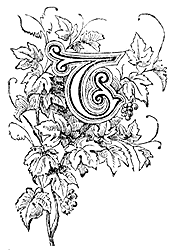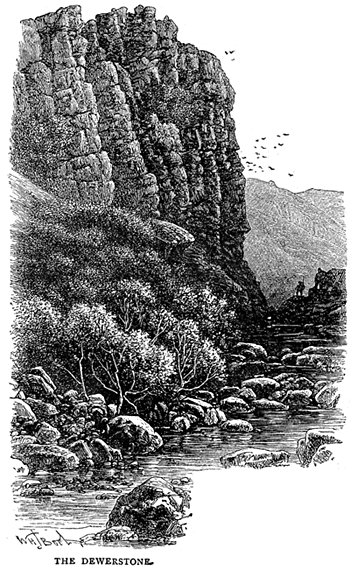 |

HIS elevated extent of heath, morass and rock measures thirty miles across from north to south, and twenty from east to west; it is computed to contain 100,000 acres. It is 1,700 feet above the sea-level, and many of the tors are still higher, Cawsand Beacon being 1,792 feet above the level of the ocean. Dartmoor was given by Edward III. to his son the Black Prince, when he invested him with the title of Duke of Cornwall, and it still belongs to the Duchy.
It is a sublime waste, and the air pure, fresh and sweet that breathes across it, is as stimulating as champagne. One's spirits rise in the freedom and vastness of the great moor.
Its most striking characteristics, however, are the granite tors, piled mass upon mass of rock, upon the summit of its highest elevations and the wild impetuosity of its streams sweeping along narrow passages at the foot of the crags.
There are also charms for the antiquarian on Dartmoor, in the remains of altars, logans and cromlechs, scattered over it, showing that it was once a sacred spot for Druid worship; names testifying to the same fact belong also to many of the tors, as Bel-tor, Mis-tor, Ham-tor, and others. Very rude are the materials of which these relics are formed, proving their great antiquity, and carrying our thoughts back for centuries to the day when the British priests burned incense to Bel or Baal, to the moon, the planets and the host of heaven; and sacrificed human victims to their false gods.
This high moor is, of course, greatly exposed to tempests; the peaks of its lofty tors intercept and draw to them the rain clouds, and great quantities of rain consequently fall during the year.
Thick mists also at times cover Dartmoor, and come on so suddenly, that people overtaken by them often lose their way and recover it with difficulty, while some have been unable to regain it, and have perished on the waste.
Nevertheless the moor is a very healthy place, from the great purity and invigorating ozone of the air, and it is said to be a fact, that no one born and bred on the moor ever died of pulmonary consumption.
There are few trees on Dartmoor, except Wistman or Whistman's Wood. It is situated about a mile north of Two Bridges, which is nearly in the centre of the moor, upon the side of a steep hill opposite Blair Down, forming the side of a valley through which a branch of the beautiful river Dart runs.
These remains of an ancient forest are supposed to have been one of the sacred groves so essential to Druidical worship, and which were full of evidences of cruelty, bodies of men being often nailed to the trees and suffered there to decay. It has been asserted by a writer on Cornwall, that Wistman's Wood is nearly in the same state now that it was at the time of the Norman Conquest.
The ascent to it is strewn with immense masses of granite, and starting from among them, wildly scattered, is a grove of diminutive oak trees, that look as if hundreds of centuries had passed since they first grew in Wistman's Wood; they are none of them above twelve feet high, and they spread wide arms at their tops, and their moss-covered branches twist and coil into each other in most fantastic fashion. Among these rocks and trees adders find a habitation. Wherever heath and bog do not interfere, the soil of the moor is good, and the pasturage fresh and juicy. Cattle and sheep are reared here, and the delicacy and flavour imparted by the herbage has made Dartmoor mutton famous for its excellence.
The Dartmoor Government prison is well known by name. It was built in 1808, for prisoners of war, but is now a jail for convicts, who are employed in all sorts of useful work, especially in reclaiming the moorland waste and bringing it into cultivation. One of these convicts occasionally escapes, but is almost invariably re-taken, as the moor is long to cross, and the paths bewildering.
Close to Wistman's Wood rises Crockern Tor. It is the spot were the ancient statuary parliaments were held. The chief tin miners of Devon were by their charter obliged to meet on the summit of this tor, when the commission was opened, the jury sworn and preliminary business settled, the court then adjourning for final decisions to one of the stannary towns. This court was held as late as 1749. The tables and seats of the stannators were hewn out of the rock, or composed of great blocks of stone. Few vestiges of them remain, but perhaps a ridge of stones on one part of the tor, and many loose ones lying about may be relics of this parliament. About two miles from Ashburton, behind Welstor Villa, is a gate leading across the common to Buckland Beacon, from which a magnificent view is obtained. Regaining the road at a ruined building called New House, a wicket gate will give access by a horse track to Rippontor, a very lofty hill 1,549 feet above the sea-level.
Many hut circles and track lines will be found on the commons. On the west side of the tor stands a logan stone, the logging powers of which still remain.
From Rippontor we may journey to the beautiful vale of Widecombe; here rural beauty is the chief thing to arrest our attention, but it is of the most exquisite kind.
There are beautiful spots all along the margin of Dartmoor, and one of the most delightful of these is Goodameavy, a very old house, said to have been one of Sir Francis Drake's earlier habitations. We must descend an exceedingly steep road down a hill overshadowed by trees to reach -it. Then we see a granite house running round three sides of a large oblong yard, the fourth side of which was closed in the old days by tremendously strong doors,the hinges of them are still visible, - for here the cattle of the farmer were shut in alike from Cavaliers and Roundheads in the civil wars of Charles I.'s reign. The walls of Goodameavy are very thick, and the windows run into the wall as loopholes of castles do; the deep apertures are too high up for window seats, or they would make good ones. But the chief beauty of the place is the famous Dewerstone Rock that rises within the grounds.
One approaches it by a lovely walk through green park land, beside a bright little salmon stream that goes dancing and singing on its way beneath the mighty cliff.
The ascent is made easy by a tramway, formed by the granite miners; for the Dewerstone Rock supplied from a large quarry in its side, the granite of which Blackfriars Bridge is built. As we stood gazing up at it, our host told us how, in order to open the quarry, the men had to be at first hung over the cliff in iron stirrups with chains round their waists, till they had excavated a good foothold, and we shuddered at the thoughts of the risk thus run. But they made a good tramway downwards, rather winding round the cliff, and of course, when the work ceased, left it for the landlord, as well as a wooden house erected for the foreman of the works; but this last has been nearly destroyed by mischievous sightseers from Plymouth and the neighbourhood, who were allowed to visit the Dewerstone, and repaid the courtesy by breaking up everything they could.
 Every step of the ascent up the Dewerstone reveals a new beauty to the eye. We look down on woods from which rises the thin blue smoke of the charcoalburner's hut, and out beyond on the dancing river, on fertile lands and distant seaa perfect landscape. We reached a broad path running round the huge cliff, where seats are placed, and gazed out with enraptured eyes on the lovely scenery; the sea distinctly visible; and from the summit (called the Eagle's Nest), we were told the Eddystone lighthouse can be seen on clear days. We did not mount to the summit, but could quite believe what a sweep of landscape it commands. Every step of the ascent up the Dewerstone reveals a new beauty to the eye. We look down on woods from which rises the thin blue smoke of the charcoalburner's hut, and out beyond on the dancing river, on fertile lands and distant seaa perfect landscape. We reached a broad path running round the huge cliff, where seats are placed, and gazed out with enraptured eyes on the lovely scenery; the sea distinctly visible; and from the summit (called the Eagle's Nest), we were told the Eddystone lighthouse can be seen on clear days. We did not mount to the summit, but could quite believe what a sweep of landscape it commands.
In making a new lawn, and turning the pathway round another, the possessors of Goodameavy discovered buried beneath it the skeleton of a gigantic man. He had evidently been very long buried; for nothing but the skeleton was left - though impressions of the buttons of his coat were left in the clay bed in which he slept. Who was he? A buccanier, murdered perhaps by his companions? or one who fell in the civil war?
There was nothing to tell the story of that skeleton; but it must have had a mystery attached to it, or it would not have been buried in the woods of Goodameavy. A watch - large and old-fashioned, but not quite a "Nuremburg egg" - was also found in the grounds.
The lady of the house, of great accomplishments and refined taste, has cultivated flowers everywhere, and not one of the least charms of the place was the bed of tall shrub-like azaleas that grew in the open air on the lawn. Groups of them, five or six feet high, are gathered close together in a flowery circle. The Auracanian pines here are also very beautiful, both male and female trees growing side by side; the latter excessively graceful, as certainly the "puzzle monkey" cannot be considered. Our hostess's father, an admiral in the navy, introduced the tree to England.
Both Devon and Cornwall are rich in flowers; the soft warm climate permitting their cultivation in the open air, and enabling them to live nearly through the whole of the English winter.
Through the moor that we pass when driving into Plymouth, runs the pure stream of water that Sir Francis Drake had carried into the town. Tradition says that he summoned the water to follow him, when he rode into Plymouth, a distance of ten or twelve miles, and the stream obeyed him, trickling after him at his horse's heels. "Warrior" (or, as the people call him, "Waryer") Drake is still thought to have had some knowledge of magic by the country people.
The church, to which the carriage took us across the moor on Sunday, has a cross and steps under an old tree outside it, on which, in the earliest days of the Reformation, the preacher used to preach to the people. An old-world county is sweet Devonshire, full of interest for the artist and the antiquarian.
|
 |